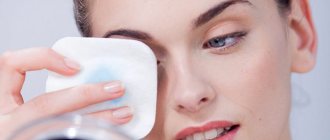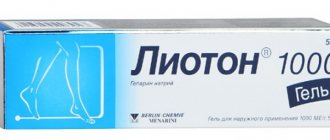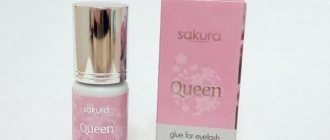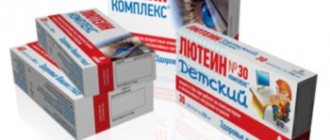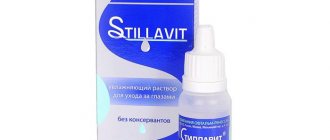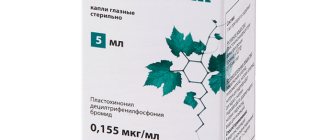After an operation such as lens replacement followed by implantation of an intraocular lens, the patient needs to use special-purpose eye drops during the recovery period. Among the variety of drops currently existing with different compositions, it is not easy to choose the ones that are suitable specifically for you.
Do not try to treat yourself after eye surgery, as this may negate the positive effect that you wanted to achieve. An ophthalmologist prescribes medications for restoration and healing and also recommends a specific regimen for taking them. Let's look at the most commonly recommended eye drops for use, and also tell you how to recover as quickly as possible after refractive lens replacement or cataract removal.
Lens removal and IOL implantation
If a patient with a refractive error is denied laser correction, the reasons for this may be:
- high degree of farsightedness or myopia;
- retinal dystrophy;
- fundus abnormalities;
- exceptionally thin cornea;
- the presence of cataracts, glaucoma.
Lens replacement surgery in such cases can save you from complete loss of vision. Lens replacement is not performed if:
- the patient is seriously ill (diabetes mellitus, cancer, multiple sclerosis, recent heart attack or stroke);
- a diagnosis of “decompensated glaucoma” was made, in which increased eye pressure is observed, which significantly complicates the postoperative period and can cause complete loss of vision;
- The patient's eyeball is too small.
When is lens replacement surgery necessary?
Before determining which drops are best to use after replacing the lens of the eye, let’s consider when surgery is necessary and what methods are used to perform it. The lens is one of the most important parts of the eye, changes in which immediately affect the quality of vision. When, over the years, the lens loses its former elasticity, and at the same time its accommodative ability, you can notice signs of presbyopia - senile farsightedness. When the lens becomes cloudy, most often in old age, the quality of vision deteriorates significantly: cataracts appear, which entails the risk of complete loss of vision.
Lens replacement is most often performed for cataracts, as this disease progresses rapidly. In addition, this operation is performed in case of dislocation or subluxation of the lens resulting from an eye injury, in cases of myopia and farsightedness that are not amenable to laser correction, as well as in presbyopia.
Efficacy of drugs
Only the initial stage of cataract is amenable to conservative drug treatment. An advanced disease requires surgical intervention and the patient will lose valuable time in search of the best pharmaceuticals. Specialized eye drops for the treatment of cataracts give results regarding acquired types of the disease and are rarely effective in relieving a disease that is senile or genetic in nature. Good remedies to prevent vision deterioration due to cloudy lenses include an antioxidant complex and vitamin supplements to nourish the eye tissue.
Operation methods
When choosing a method for replacing a lens with implantation of an artificial intraocular lens, the doctor pays attention to the patient’s age, general health and, of course, the course of his eye disease. Currently, lens replacement is carried out using two methods. Extracapsular extraction. This method is a micro-incision of the tissue between the sclera and the cornea, through which the damaged lens is removed, and where the prosthesis is then placed. After which the incision is sutured, and the patient is hospitalized. The stitches are removed after about 3 months. Ultrasonic phacoemulsification. There are several advantages of ultrasonic phacoemulsification. The operation is performed on an outpatient basis in one stage. A micro-incision is created into which an ultrasonic probe is inserted to liquefy the lens. Afterwards, the lens is pumped out and an intraocular lens is installed in its place. No stitches are required during this operation, and hospital treatment is not required.
The prosthesis that is installed in place of the removed lens is called an intraocular lens. You can choose an implant based on several indicators:
- rigidity;
- focus;
- accommodative ability.
Soft lenses will cost the patient more because they are more functional and can be installed with a smaller incision than hard ones. Prostheses are also divided into mono-, bi- and multifocal, which correspond to the number of points at which a clear image will be formed. The fewer tricks, the more often the need for spectacle correction will arise. The patient can choose an implant, which determines the final cost of the operation. In general, the operation is absolutely painless and takes no more than 15-20 minutes.
How to choose the best moisturizing eye drops? List of the most effective drugs
UTE%20BCN/Organic-Silica.jpg» />The category of moisturizing ophthalmic preparations is a special type of eye drops that do not perform therapeutic functions.
They serve to relieve symptoms of fatigue and partially restore the natural tear film , and also provide protection to the organs of vision from external factors.
There are many such products that may differ in composition and principle of action.
How moisturizing eye drops work
Moisturizing ophthalmic solutions perform several functions at once, including:
- moisturizing the cornea;
- thickening of the protective mucin (tear) layer;
- increasing the viscosity characteristics of tear fluid;
- formation and restoration of the tear film.
Many drugs are identical in composition or close to natural tear fluid, so they not only do not cause discomfort, but also do not affect the refraction of light.
Indirectly, such drugs can even serve as a prophylactic against cataracts, glaucoma and less serious diseases, as they have keratoprotective (protective) properties, neutralizing the impact of negative external factors on the visual organs.
Types of moisturizing solutions
- Exclusively moisturizing preparations .
Their main purpose is to moisturize the conjunctiva and cornea when diagnosed with dry eye syndrome.
- Vitamin and mineral drops.
- Products for those who have to wear contact lenses.
- Visomitin.
- Systane ultra.
- Natural tear.
- Inoxa.
- Oksial.
- Hilo chest of drawers.
The solution is often used for problems with eye hydration resulting from the use of contact optics.It is recommended to instill drops at least three times a day, one drop in each eye.
- Vizmed.
- Slesin.
They are closest in composition to natural tear fluid, but in addition to moisturizing and protecting the eyes, they also nourish the tissues of the eyeball with the microelements necessary for normal functioning.
Often used by people who constantly work at the computer.
In this category of people, while using contact optics, dry eye syndrome often develops and tissue repair processes may even be disrupted.
Moisturizing solutions help prevent this.
In some cases, drugs from different groups can be combined, although most often just some drops are sufficient.
Moisturizing drops for adults
For adult patients, the following eye moisturizers can be recommended:
Despite the fact that side effects often occur when using this drug, Visine remains the most popular drug due to its availability.
The drug eliminates the feeling of dryness and “sand” in the eyes, and you do not need a prescription from a specialist to purchase it.
It is recommended to instill the drug no more than three times a day at equal intervals, one or two drops in each eye.
But if the medicine is prescribed by an ophthalmologist, you must adhere to the regimen prescribed by him.
An almost complete analogue of Vizine, which is prescribed in case of side effects when using Vizine.
Sometimes this medicine is used as an additional remedy in the treatment of cataracts and conjunctivitis of various origins.
The solution is instilled three times a day, one drop at a time.
A remedy to relieve symptoms of fatigue, irritation and dry eyes.
The medicine contains not only moisturizing substances, but also vitamins that strengthen the tissue of the eyeball.
There are no strict restrictions in terms of the number of instillations of this product - it can be instilled throughout the day as the feeling of eye fatigue increases, a couple of drops at a time.
A synthetic drug that is a complete analogue of tear fluid.
It can be used not only for adults, but also for children, although in the second case a preliminary consultation with an ophthalmologist is recommended.
Approximately every two to three hours, one drop is instilled into each eye.
The drug not only moisturizes and protects the conjunctiva, but also has a weak antihistamine effect, so it is sometimes prescribed for the complex treatment of eye allergies.
If used solely for moisturizing, instill inox as needed. In all other cases, consultation with a doctor is required.
Drops for children
This is a combination drug, one of the functions of which is to moisturize and strengthen the mucous membrane.
For such purposes, it is enough to instill the product up to three times a day, one drop at a time.
They act as anti-inflammatory and moisturizing drops, which additionally have a restorative effect on the tissue cells of the cornea.
Depending on how severe the dry eye syndrome is, drops are used one to three times a day.
Eye drops with hyaluronic acid
Among these drugs you can choose the following:
A drug for moisturizing the conjunctiva and protecting it from external factors and irritants: dust, bacteria, foreign bodies.
The product promotes the formation of a stronger protective film on the surface of the eyeball and its uniform distribution over the surface of the eye.
Drops can be instilled 3-6 times a day.
Drops to replenish the deficiency of tear fluid and restore the tear film.
The drug does not contain preservatives and can be used even when wearing contact lenses (the optics do not need to be removed during instillation).
List of inexpensive products
Among the inexpensive eye moisturizers, the following are preferred:
The drug forms a strong tear film and does not distort vision, and also has a moisturizing effect.
It has the longest contact with the cornea, as it contains the viscous component hypromellose.
It is not recommended to use this product without breaks for more than three weeks.
Every day you can do no more than eight drops (two drops in each eye).
One of the most “neutral” drugs that can be used for moisturizing at any age.
In addition to dry eye syndrome, the drug is prescribed as a prophylactic solution for lacrimation disorders resulting from ophthalmological diseases or injuries.
Depending on the need, it is instilled every 3-5 hours.
The most effective drugs
Unlike hilo-chest, vizmed can be used more often (three to five times a day or more).
Although this drug contains synthetic components and additives, it still causes allergic reactions even if the patient is hypersensitive to such substances.
By using Vismed throughout the day, you can quickly get rid of dry eye symptoms such as burning, itching, irritation and fatigue.
Contraindications for use
Among all other categories of ophthalmic drugs, moisturizing drops have the fewest contraindications.
And also, if you are prone to allergic reactions , some moisturizing solutions can cause a negative reaction in the body, so if you notice the first symptoms of an allergy (itching, irritation and redness of the conjunctiva), you should discard the drops and choose an alternative.
Patient reviews
“When I first encountered the problem of dry eyes , I experimented for a long time, trying expensive and cheap products. In the end, I decided to settle on a teardrop .
This is a natural product that
does not cause for me and allows me to work comfortably at the computer all day . In addition, if necessary, such a product can easily be purchased at any nearby pharmacy, which cannot be said about some expensive and supposedly “more effective” products.”
Anton Leontyev, Volgograd.
“ My daughter is in the eighth grade and due to heavy strain on her eyes during lessons, several months ago she began to get very tired , citing the fact that reading and using the computer cause discomfort.
When visiting an ophthalmologist , it turned out that the girl had dry eye syndrome .
Unfortunately, it turned out that this is not only a problem for adult office workers, but the doctor reassured us and recommended using the drug natural tear , and if it does not help, instill hilo-chest in accordance with the instructions.
For now we are making do with only natural tears: my daughter no longer complains about eye fatigue .”
Elizaveta Pekova, Kostroma.
Recovery process
After replacing the lens of the eye with an intraocular lens, a recovery period begins, during which you must unconditionally follow all the recommendations of the ophthalmologist. Taking medications correctly and following general instructions after surgery are no less important than the manipulation itself. Without proper care, the eye will not be able to recover, and a number of complications may arise:
- displacement of the prosthesis;
- inflammatory process;
- intraocular bleeding;
- increased intraocular pressure;
- retinal detachment.
A normal reaction to eye surgery is pain during the first 24 hours, burning, discomfort and a feeling of fogginess, which soon disappear.
General recommendations
You will begin to feel improvement just a few hours after the operation, and within a month your vision will be fully restored. In addition to eye drops after eye surgery, the ophthalmologist prescribes general recommendations regarding the recovery period. If you follow them strictly, the likelihood of complications will decrease significantly.
- Any physical activity after eye surgery is contraindicated. It is necessary to visit an ophthalmologist in a timely manner, who will monitor the condition of the eyes in the postoperative period.
- It is strictly forbidden to rub or scratch the eyes, as this can dislodge the implant.
- It is necessary to wash your face with extreme care, avoiding getting soap or cosmetics into your eyes.
- Sleeping on the side of the operated eye is not recommended.
- Be sure to use eye drops as prescribed by your doctor.
Dry eye syndrome after laser correction
Dry eyes are a fairly common phenomenon that can be a symptom of arthritis or thyroid disease, a reaction to dry or dirty air, a side effect of antihistamines, etc. The most effective method of treating dry eye syndrome is eye drops. Their choice is quite wide, so later in the article we will look at the types of drops for dry eyes and talk about the features of using the drugs.
Application area
Dry eyes or dry eye syndrome is an eye disease caused by insufficient eye moisture. A lack of moisture in the eyes occurs due to decreased tear production or increased evaporation of tears.
Tears are essential for maintaining eye health and ensuring clear vision. People with dry eye syndrome produce insufficient tears or have abnormal properties and quality of tears.
Causes of dry eyes:
- Chronic inflammation of the eyelids and conjunctiva;
- Eye diseases (keratoconus, cicatricial deformities of the eyelids, conditions after laser surgery);
- Endocrine diseases (diabetes mellitus, thyroid disease, menopause);
- Systemic autoimmune diseases (rheumatoid arthritis, systemic lupus erythematosus);
- Chronic hepatitis;
- Neuritis of the facial nerve;
- Constant use of medications (corticosteroids, oral contraceptives, antidepressants, diuretics);
- Elderly age;
- Incorrect computer operation mode.
People with dry eye syndrome experience the following symptoms:
Increasing severity of dry eye syndrome can cause damage to the cornea and blurred vision. Treatment for dry eye aims to restore and maintain normal tear production and maintain eye health.
Features of the drugs
Moisturizing eye preparations can be used both to prevent the development of dryness and eye fatigue, and to treat dry eye syndrome . Some of them can be used independently, even without a doctor’s prescription, if your activity involves working on a computer.
Preparations for moisturizing the eye membrane, unlike specialized products, have almost no therapeutic effect. They can only be used for prevention or rapid restoration of the normal state of the mucous membrane.
Indications for the use of eye drops for dry eyes:
;
Redness- Watery and puffy eyes that occur in response to exposure to cosmetics, bright lighting, washing water, smoke and dust;
- Blepharitis, conjunctivitis and keratitis;
- Eye irritation from contact lenses;
- Prolonged visual tension.
Drops can also be used as complex therapy for infectious eye diseases simultaneously with antimicrobial, antifungal and antiviral therapy.
Eye drops for dryness are classified into several types depending on what effect they have: eliminate redness, relieve fatigue, etc. Next are the types of drugs and the features of their use.
Moisturizing drops
The main function of moisturizing drops is to quickly moisturize the mucous membrane and increase its density. Such drops are a product of artificial tears and are not at all dangerous.
- Natural tear. These drops moisturize the mucous membrane, their effect lasts up to 1.5 hours. Suitable for any people.
- Vidisik. Drops relieve dry eyes and moisturize the conjunctiva. The drug is available in pharmacies without a prescription.
- Hilo chest of drawers. Contains hyaluronic acid, therefore it also has a slight therapeutic effect. The drops create a film on the cornea that protects the eyes from further damage.
- Visomitin. The drug eliminates eye burning and dryness.
- Lincontin. Drops are used for dry eye syndrome, visual fatigue, and when wearing contact lenses. Sometimes prescribed for the purpose of prevention.
A distinctive feature of such drops is that their composition is as close as possible to the composition of tears, but they do not treat the main problem of the disease of the organs of vision, but only contribute to the rapid restoration of the mucous membrane of the eye.
Eye drops for dryness and fatigue
A distinctive feature of this type of drops is that vitamins are added to their composition, which promote hydration and restore visual acuity. Such products are recommended for those who spend a lot of time at the computer, reading, or any activity where the gaze is concentrated on one point.
- Ophtolic. Inexpensive drops for dry eyes help restore damaged corneas. Sold only with an ophthalmologist's prescription.
- Opt. The solution is used when there is insufficient production of tear fluid. Restores corneal cells and protects eyes from penetration of microorganisms. The drug has side effects: redness of the eyelids and conjunctiva, so it is allowed to be used only after 18 years of age.
- Taufon. Drops are prescribed to adults with impaired tear synthesis, which provokes irreversible changes in the cornea. The course of treatment with this drug is 10 days, no side effects have been identified.
- Artelak. Effective domestic drops for intensive hydration of the corneal epithelium. By quickly softening the fabrics, they increase clarity of vision, relieve fatigue, and make blinking easier.
- Blink intensive. Drops protect and normalize the condition of the mucous membrane of the eyes. Contains the latest generation moisturizing component - polyethylene glycol.
- Thealosis. A drug for lubricating and thickening the mucous membrane in order to restore it. Prescribed in connection with fatigue and dry eye syndrome, as well as for accelerated tissue restoration after laser correction. Enriched with trehalose.
- Innoxa Cornflowers. The best drops for dryness and fatigue, as well as for the treatment of redness of the conjunctiva and protein. They thicken the corneal mucosa and make the process of putting on and taking off lenses easier.
Remedies for dry eyes and puffiness
Such drugs are used for various eye diseases, and therefore cannot be used without a doctor’s prescription.
- Diklo-F. They are used for non-infectious conjunctivitis, after operations and to reduce the symptoms of dry eye syndrome.
- Voltaren-ofta. The drug is used to reduce the photosensitivity of the eye, during inflammatory processes, eye irritation, after surgery.
Moisturizing eye drops when wearing contact lenses
For contact lens users, there are special moisturizing drops that provide additional protection for the eyes. They can be dropped directly onto contact lenses.
Such drugs include:
Vasoconstrictor and antiseptic drops
Due to the dryness of the cornea and conjunctiva, not only lacrimation, but also the blood supply to the eye is often disrupted. The result is redness, swelling, itching and a constant sensation of a foreign body on the mucous membrane.
To remove these and many other symptoms, ophthalmologists prescribe specialized antiseptics, vitamin and vasoconstrictor compounds to patients.
- Aistil. Vitamin ophthalmic complex used to restore visual acuity and eliminate corneal dryness. This natural remedy is suitable even for children. Does not contain any dyes or preservatives.
- Quinax. The product improves vision, helps normalize the exchange of oxygen and blood, and strengthens the mucous membrane. Enriched with azapentacene.
- Emoxy optic. The drug is characterized by powerful antioxidant and antiseptic effects. Can be used to treat dry mucous membranes resulting from eye contamination. Contains emoxypine.
- Vita-Iodurol. Improves blood supply to the eyeball, relieves fatigue, returns sharpness and clarity to the eyes after prolonged exposure to light. Contains calcium and magnesium chloride.
Recommendations for use
The first thing to do for any eye discomfort is to visit an ophthalmologist. A consultation with a doctor will never be superfluous. If dry eyes do not go away for more than a week, then contacting a doctor becomes a mandatory measure.
Different brands of drops have different ingredients (hyaluronic acid, hypromellose, carbomer, povidone, etc.). The components in the drops may be suitable for some people and not for others. The doctor must take this fact into account when choosing a drug.
For example, artificial tear preparations may contain preservatives, which may cause irritation in some people. Remember this if you feel burning and pain in your eyes after using the drops. Some eye drops may cause side effects , such as: Bromfenac eye drops
A description of Broxinac eye drops with instructions for use is presented in this article.
Clouding of the cornea https://eyesdocs.ru/zabolevaniya/redkie-bolezni/bel...-vidy-simptomy-i-lechenie.html
In such cases, you should immediately stop using the drug and consult a doctor.
Eye drops must be used correctly. The main rule is hygiene. Before using the products, hands should be washed thoroughly using a disinfectant.
Under no circumstances give your bottle of drops to another person for use. You should also not use other people's medications.
Dry eyes are a symptom that causes discomfort. You can get rid of it using drops for dry eyes. As you can see, there are quite a lot of drugs in this area and they need to be used wisely. An ophthalmologist will help with this. Many eye drops are sold without a prescription, but you should not self-medicate; it is always better to go to your doctor for advice. Only a specialist can choose the most suitable option that will help solve the problem as effectively as possible. When used correctly, drops for dry eyes will not cause harm.
Also read about what diseases are preceded by blurred vision and double vision.
Eye drops after surgery
Eye drops after cataract surgery should be used for two weeks during the recovery period. The attending physician also prescribes eye medications that do not contain steroids. They can relieve inflammation and protect the eye from harmful bacteria. Although such drops are less effective, they can nevertheless be instilled for two months. After cataract surgery, drops of various effects are prescribed, but they must be taken simultaneously according to a special regimen:
- disinfectants;
- antibacterial;
- anti-inflammatory;
- steroid.
It is necessary to remember that after surgery, self-medication can be detrimental to eye health; it is strictly forbidden to use drops without a prescription from an ophthalmologist and his consultation on the correct use.
Limitations after lens replacement
Compliance with all restrictions will speed up the recovery period after lens replacement and will also reduce the risk of postoperative complications. Within a day after the intervention, the patient can take a shower, wash his hair and wash his face. It is important that during hygiene procedures, no soap, shampoo or other detergents get into the operated eye. Listed below are some restrictions after lens replacement surgery, which are strongly recommended to be adhered to during the first two weeks after surgery:
- Avoid intense physical activity and heavy lifting.
- Avoid tilting your head below the waist during the first month.
- It is not recommended to rub or press on the operated eye.
- It is not advisable to wear eye makeup for one week after lens replacement surgery.
- It is not advisable to visit a pool or swim in open water, as well as visit a sauna or bathhouse.
- You cannot stay in the bright sun for a long time without sunglasses.
- Doctors recommend not sleeping on the side of the eye that has undergone surgery.
There are practically no restrictions on diet after this intervention. Proper nutrition and sufficient fluid intake are recommended. If constipation occurs, it is advisable to take laxatives to avoid injury to the eye when straining.
All restrictions are temporary and are aimed at the fastest healing of the eyeball. By following these simple rules, you will achieve the fastest possible restoration of vision and reduce the risk of postoperative complications.
Regimen for taking drops after surgery
For taking eye drops after lens removal, there is a special regimen designed to reduce the daily dosage every week for five weeks.
- First week after surgery. Instillation 4-5 times a day.
- Second week - 3-4 times.
- Third week - 2-3 instillations.
- Fourth - 1-2.
- Fifth. Use drops once a day. If there are no complications, then the course of treatment with eye drops can be stopped.
This is not the only possible schedule for taking medications after lens removal surgery. In each individual case, the ophthalmologist decides on the dosage regimen. If you must instill several eye medications at the same time, it is recommended to use them at short intervals. In some cases, the specialist gives the patient a calendar where it is necessary to record the days and exact time of taking a particular medicine. This will help the patient not to forget or mix up the drops.
Features of cataract drops
Depending on the composition, cataract drops can have the following therapeutic effect on the soft tissues and muscles of the eyes:
- normalize electrolyte metabolism and moisture content in the muscles of the eyeball due to the content of inorganic salts;
- eliminate dystrophic changes in the visual apparatus by replenishing the deficiency of minerals and vitamins;
- improve the flow of redox processes in the fibers of the lens, retina, cornea, ensuring local supply of organic compounds.
There are also medications in the form of drops and solutions used during the recovery period after lens removal, which eliminate the consequences of surgery (pain, swelling), promote rapid healing and prevent possible complications of the operation.
The process of instilling any drops after surgery
- Disinfect your hands;
- Lie on your back or tilt your head back;
- The drug must be kept near the operated eye;
- Pull back the lower eyelid;
- Press the bottle so that a drop falls onto the surface of the eye;
- Blink, thereby evenly distributing the product;
- Close up drops.
The tip of the bubble should not touch the eye, because this way you can get an infection. Hold the lower eyelid with a clean disposable tissue; if a drop comes out of the eye, do not wipe your eyes with your hands.
Eye drops after eye surgery
Disinfectant drops
"Furacilin"
An alcohol or aqueous solution of furatsilin has antiseptic and antimicrobial properties. Furacilin slows down the proliferation of the microbial environment or suppresses it completely. In ophthalmology, the solution is used in the complex treatment of wounds, burns, blepharitis, and conjunctivitis. In the form of eye drops, Furacilin is instilled in the form of a solution.
Method of use of "Furacilin" Furacilin solution has a wide spectrum of action: washing the eyes for blepharitis, eye injuries, as well as in case of foreign body penetration, conjunctivitis and other infectious eye diseases. The prepared aqueous solution of furatsilin needs to be used only once; for subsequent washes, a new portion of the solution is prepared. It is recommended to rinse the eyes using disposable cotton pads or by irrigation (using a bulb or syringe). You can also use a pipette to drop the solution into each eye. After treating the eyes with an aqueous solution of furatsilin, ophthalmologists recommend lubricating the edges of the eyelids with furatsilin ointment for greater effect.
Contraindications The solution is contraindicated in case of hypersensitivity to the active component, dermatosis, bleeding. In any form, furatsilin should be used with extreme caution in those patients who suffer from severe renal impairment.
Side effects
- nausea, loss of appetite, vomiting;
- dizziness;
- neuritis;
- allergic reaction;
- dermatitis.
Price The price for this drug, as for other eye drops, varies depending on the region. On average it is 30 rubles.
Antibacterial drops
"Vitabact" Vitabact eye drops are a medicine prescribed to patients for the prevention and treatment of inflammatory processes in the eyes, and also as an antibacterial agent after replacement of the eye lens.
Pharmacological properties The main active component of these drops is piloxidin. Vitabact drops have a powerful antiseptic effect, relieve all signs of inflammation, and also fight various infections. The presented eye drops are highly effective in the fight against pathogenic cocci, shigella, viruses, fungi, E. coli, and chlamydia.
Indications for use of the drug According to the instructions for use, “Vitabact” is prescribed in the following cases:
- inflammatory and infectious eye diseases such as keratitis, blepharitis, conjunctivitis, dacryocystitis;
- inflammatory processes of the eyes caused by the proliferation of chlamydia;
- prevention of inflammation after eye surgery: removal of the lens, cataracts;
- for preventive purposes, once only in case of close contact with a carrier of viral conjunctivitis.
Contraindications Vitabact eye drops are contraindicated only for those who have a personal intolerance to the active component of the drug.
Method of administration and dosage This medicine, like any other in the treatment of eye diseases or in the postoperative period, can only be used as prescribed by an ophthalmologist. The duration of the course of treatment, as well as the required dosage, is prescribed by a specialist. Vitabact eye drops should be instilled into the conjunctival sac, 1-2 drops 2-6 times a day according to indications. Before instilling the drug, you must disinfect your hands. If dried particles of pathological fluid have accumulated on the eyelashes, then before irrigation they must be carefully removed with a cotton swab, previously moistened in clean boiled water or a solution of an antiseptic drug (for example, furatsilin) in the direction from the outer to the inner corner of the eye. In case of acute inflammation, drops should be instilled about 6 times a day, and as the symptoms subside, the dosage is reduced to 3 times. For prophylaxis after eye surgery, the ophthalmologist prescribes irrigation with Vitabact drops, 1-2 drops into the conjunctival sac approximately 2-3 times a day for 3 days. Vitabact is also used in case of contact with a carrier of viral conjunctivitis or keratitis, for the purpose of prevention - 1-2 drops in each eye once.
Price The estimated cost of the drug is from 300 to 350 rubles.
"Tobrex" Eye drops "Tobrex" is an antibiotic for local use. "Tobrex" is used in ophthalmology to treat infectious pathologies of eye structures. The active ingredient is tobramycin. The drug has a wide spectrum of activity against various types of pathogenic bacteria.
Indications for use The use of Tobrex eye drops is necessary for various infectious and inflammatory eye diseases:
- blepharitis;
- keratitis;
- conjunctivitis;
- keratoconjunctivitis;
- iridocyclitis;
- prevention of postoperative complications and inflammation.
Tobrex eye drops are intended for external irrigation locally. From a dropper bottle, they are carefully instilled, without touching the tip of the vessel, into the conjunctival sac of the infected or operated eye. Depending on the severity, the drug is used in mild and moderate cases, 1-2 drops every 4 hours. In severe cases of the infectious process, the eye is irrigated with a solution every half hour to an hour; as the symptoms of inflammation decrease, the frequency of instillation must be reduced.
Price The price for the eye antibiotic “Tobrex” is 150-200 rubles.
Eye drops for cataracts and glaucoma
Eye drops for glaucoma are prescribed if surgical treatment is not possible.
Your attending physician will help you choose the appropriate medication, taking into account how advanced the glaucoma and cataracts are. There are different drugs that differ in their effects on sore eyes.
Many of them help to effectively treat pathology and partially restore vision only after prolonged use.
Types of eye drops for glaucoma and cataracts
Eye drops differ in composition and therapeutic effect. For different types of pathology, it is recommended to use different medications.
For angle-closure glaucoma, the use of eye drops that constrict blood vessels is strictly prohibited. In this case, it is possible to provoke contraction of the iris, in which the pupil is located.
In open-angle forms of pathology, on the contrary, such medications are indicated for use.
Intraocular drops are often prescribed for cataracts and glaucoma, which have an anti-inflammatory effect. It is strictly forbidden to use medications of this type on your own, as complications are possible.
Commonly used anti-inflammatory medications:
- "Indocollier";
- "Nevanak";
- "Diklo-F";
- "Broxinac."
Reduces fluid production inside the eye
The initial stage of the pathology allows the use of Arutimol.
Such drops for the treatment of glaucoma and cataracts are necessarily included in complex therapy. They are prescribed in the initial stages of eye disease. At first, it is better to use beta blockers for treatment, presented in the table:
| Active substance | Drug names |
| Timolol | "Arutimol" |
| "Ocumed" | |
| "Okumol" | |
| "Okupres-E" | |
| Betaxolol | "Betoptik" |
| "Betoptik S" |
If such drugs do not help against closed-angle or open-angle glaucoma, then strong medications are used. Medicines suppress carbonic anhydrases, which are required in the production of intraocular fluid. These drops include:
- "Azopt";
- "Trusopt";
- "Dorzopt."
The two-component drug Azarga promotes faster vision restoration.
You can instill combined products of similar action, containing 2 potent components. In this case, the effect is enhanced, and the patient’s vision function improves. You can use the following medications:
Medicines that improve the outflow of intraocular fluid
If, after patients have instilled products containing beta blockers, low effectiveness is noted, then stronger medications are required. Then the doctor prescribes good eye drops for glaucoma, which help to increase the outflow of fluid formed inside the eye. List of effective drugs:
Double acting medications
For severe cataracts and glaucoma, it is recommended to drip products with double action into the eyes. After their use, there is an improvement in fluid outflow and a reduction in its production. The most commonly used medications are:
Timolol helps solve two problems at once in advanced pathology.
- "Brimonidine";
- "Latanoprost";
- "Timolol";
- "Xalacom";
- "Luxfen".
Such drops are best used for open-angle glaucoma, since they do not affect the pupil and do not change the angle of the anterior chamber of the eye.
Universal medicines
The main drops of general action include “Fotil” and “Fotil forte”. They are used for cataracts and various types of glaucoma. The composition of the first medication includes the following components:
- Timolol. The substance reduces the production of intraocular fluid.
- Pilocarpine. Aimed at narrowing the pupil and opening the angle of the eye chamber located in front. Thanks to this component, the outflow of intraocular fluid improves.
In Fotil Forte drops the volume of pyocarpine is doubled, which is why it has a better effect. Treatment regimens for such medications for cataracts are coordinated with the treating doctor, since drops often eliminate some symptoms, but provoke the occurrence of others
There are several contraindications that are also important to consider before use.
Pupil dilation
Drugs with this effect can be used for spasms of accommodation.
This type of medication is prescribed for the diagnosis of cataracts and glaucoma. There are also other indications for their use:
- before surgery;
- spasm of accommodation resulting from prolonged visual stress.
List of commonly used drops that dilate the pupil:
- "Irifrin";
- "Mydriacyl";
- "Tropicamide".
List of commonly used drugs
Some drops for glaucoma and cataracts are used much more often than others, which is associated with greater effectiveness and an affordable price. Popular means for reducing intraocular pressure and eliminating other unpleasant manifestations:
Betoftan is one of the frequently prescribed drugs for eye diseases.
How to use?
You need to instill no more than two drops into the area of the conjunctival sac.
Even the best drops sometimes have a negative effect if you don’t know how to instill them correctly.
Intraocular agents for prevention or treatment are prescribed by an ophthalmologist to prevent serious complications. The doctor also indicates the permissible dosage and duration of therapy.
Drops are injected into the conjunctival sac 1-2 times a day.
After instillation, the eye is closed tightly so that the medicinal components are better absorbed into the bloodstream. Such measures will also help avoid adverse reactions.
If the treatment of cataracts and glaucoma is carried out with several intraocular agents at once, then special rules must be followed
First of all, it is important to carefully study the instructions for each drop and determine whether it is possible to combine them with each other.
Also observe the interval specified in the instructions between instillation of different medications. On average, you need to wait 20-25 minutes before using the next drops.
Anti-inflammatory eye drops
"Diclo-F" The active component of the drug, diclofenac, has a local antipyretic, as well as anti-inflammatory and analgesic effect. Diklo-F eye drops are necessary to prevent complications after surgical procedures, for example, after cataract removal. The drug penetrates well into various tissues of the eye in addition to the lens.
Indications for use
- miosis during cataract surgery;
- non-infectious conjunctivitis;
- treatment and prevention of inflammation after operations on the visual organ;
- treatment and prevention of inflammation after eye injury;
- prevention of cystoid macular edema after cataract surgery or lens replacement.
According to the instructions, Diklo-F should be dripped into the conjunctiva of the affected eye. Prevention of cystoid macular edema: 1 drop 3-4 times a day for 2 weeks after surgery. For other indications, the drug is recommended to be used 1 drop 3-4 times a day, depending on the severity of the disease. The duration of treatment with this drug is 1-2 weeks.
Price The price of the medicine is on average about 150 rubles.
"Indocollir" The drug "Indocollir" is a non-steroidal anti-inflammatory drug used to treat various eye diseases. Prescribed for local use in ophthalmology. "Indocollir" has an anti-inflammatory and analgesic effect.
Indications for use The medicine is prescribed to patients with the following conditions:
- prevention of the development of miosis against the background of eye surgery;
- treatment and prevention of infections after eye surgery;
- prevention of eye swelling after cataract surgery;
- treatment of infectious conjunctivitis;
- prevention of the development of infections in the eye after injuries and damage to the mucous membrane of the organs of vision.
Contraindications for use This drug can only be used as prescribed by an ophthalmologist after lens replacement. Before instilling drops into the eyes, the patient must carefully read the instructions. "Indocollir" has the following contraindications:
- individual intolerance to the components included in the composition;
- allergic reaction to acetylsalicylic acid or non-steroidal anti-inflammatory drugs;
- bronchial asthma;
- allergic rhinitis;
With caution: patients with impaired blood clotting function or congenital blood diseases.
Method of use and dosage The dosage and duration of treatment with eye drops after surgery is determined by a specialist. According to the instructions, to prevent the development of postoperative miosis, the drug must be instilled 1 drop every half hour 4 times immediately before surgery. For the treatment of inflammatory processes due to injury or other visual pathologies, the drug is prescribed 1-2 drops in each eye 4 times a day at equal intervals. The duration of the course of taking the drug is no more than two weeks. If the course is completed, but there is no improvement, you need to contact the ophthalmologist again.
"Naklof" This is an analgesic, non-steroidal anti-inflammatory drug used in ophthalmology. Diclofenac, as the active substance of the drug, is able to stop miosis (constriction of the pupil) during cataract surgery, while reducing inflammation and pain in the eye caused by damage to the corneal epithelium.
Indications
- inflammatory processes after replacement of the eye lens.
- post-traumatic inflammatory processes.
Method of application Before surgery, it is necessary to perform 5 irrigations of 1 drop each within three hours. After surgery - 1 drop three times a day, then - 1 drop up to 5 times daily, the duration is determined by the ophthalmologist in each individual case. To relieve pain, a drop is prescribed every 4-6 hours. If the pain is caused by a surgical procedure, then prescribe 1-2 drops an hour before surgery and 1-2 drops immediately after surgery.
Contraindications
- individual hypersensitivity;
- urticaria, bronchial asthma, acute rhinitis associated with taking acetylsalicylic acid or other drugs that suppress the synthesis of prostaglandins;
- hypersensitivity to phenylacetic acid derivatives or other non-steroidal anti-inflammatory drugs.
With caution: during pregnancy and lactation.
Side effects
- burning sensation;
- thinning of the cornea, ulcer;
- punctate keratitis, damage to the corneal epithelium;
- itching, redness of the eyes, blurred vision.
Price The price for this drug varies in pharmacies across the country from 100 to 200 rubles.
there steroid eye drops ?
"Torbadex" The drug "Tobradex" is an antibacterial agent with an anti-inflammatory effect for local use in ophthalmology after lens replacement.
Indications for use Tobradex drops are prescribed to patients for eye irrigation for the prevention and treatment of ophthalmological diseases, namely:
- keratitis;
- conjunctivitis;
- blepharitis;
- eye injuries;
- previous operations to prevent infectious complications in the eye;
- entry and removal of a foreign object from the eye.
Contraindications Before introducing Tobradex drops into the eyes after replacing the lens, you must carefully read the instructions, since this drug has several contraindications: viral inflammation of the eyes, for which the drug is ineffective, fungal infection, age under 2 years, conditions after removal of a foreign body from the cornea , individual intolerance to the components of the medication. Relative contraindications to the use of the drug are pregnancy and lactation.
Method of administration and dosage Tobradex eye drops are prescribed to patients for instillation into the conjunctival sac, 1 drop. The drug is instilled up to 6 times a day every 4 hours. The treatment period usually lasts 5-7 days; if symptoms do not stop, you should consult an ophthalmologist.
Side effects As a rule, eye drops after Tobradex surgery are well tolerated, but if the dose is exceeded and the patient is hypersensitive to the components of the drug, some side effects may develop:
- swelling of the eyelids;
- feeling of “sand” in the eyes;
- hyperemia of the mucous membrane of the eyes;
- itching and burning in the eyes after irrigation;
- blurred vision;
- increased intraocular pressure (due to dexamethasone included in the drug);
- cataract formation.
Price Eye drops after cataract surgery “Tobradex” cost 360 rubles.
"Maxitrol" "Maxitrol" is an antibacterial drug that inhibits inflammatory processes. "Maxitrol" is a combination drug and is intended for local use. The active component, neomycin, has a pathogenic effect on Staphylococcus aureus, Friedland's bacillus, Escherichia coli and Haemophilus influenzae, Proteus vulgaris, streptococcal bacteria and diphtheria pathogens, as well as gram-negative rod-shaped bacteria.
Indications for use This medication is prescribed for the following eye ailments:
- iridocyclitis;
- conjunctivitis;
- keratoconjunctivitis;
- keratitis;
- blepharitis;
Contraindications
- intolerance to the components of the drug;
- mycobacterial eye infections;
- purulent infections on the mucous membranes of the eyelids and eyes;
- herpes zoster in the acute stage;
- purulent corneal ulcer;
- the period after removal of the foreign body of the cornea;
- fungal eye diseases;
- viral eye diseases;
- tuberculous eye diseases;
- prevention of complications after eye surgery.
Dosage Infectious process: 1-2 drops, 4 or 6 times a day. Complex infectious process in the acute stage: 1-2 drops every hour. As the symptoms of the disease decrease, the number of instillations decreases gradually.
Side effects The use of Maxitrol after lens replacement can cause undesirable effects in the form of allergies: itching, swelling of the eyelids, conjunctival hyperemia. The steroid active agent of the drug may cause increased intraocular pressure. If treatment lasts more than 10 days, it is recommended to monitor intraocular pressure. It is worth noting that long-term therapy with steroid drops can lead to a fungal infection in the cornea.
Price The price of eye drops after eye surgery “Maxitrol” ranges from 450 to 550 rubles.
Remedies against cataracts
Drops for the treatment of cataracts are based on many vitamins, enzymes, trace elements and amino acids. They perform the following functions:
- improve metabolism in the soft tissues of the eyes;
- nourish and oxygenate cells;
- accelerate metabolic processes;
- nourish, cleanse and strengthen blood vessels;
- accelerate recovery processes in the affected walls of the eye;
- slow down the oxidation processes of free radicals, so that protein does not accumulate in the lens.
From this list, the main objectives of drugs are to nourish cells and blood vessels and prevent protein accumulations in the lens of the eye.
The scar is not waterproof enough partial fall of the upper eyelid hematoma under the conjunctiva or the perception of flying flies on the eyelids increased sensitivity to mild inflammation of the eye increased intraocular pressure corneal astigmatism diplopia critical error in power calculation. Sometimes a second intervention may be required. . Marco Lombardo and his staff offer consultations on cataract diagnosis and surgical treatment. Cataract surgery is performed using the most advanced techniques and instruments in the field of local anesthesia and outpatient surgery.
Eye drops for cataracts have their own characteristics and require proper use. Only under this condition can good and lasting results be achieved. Many drops for eye cataracts have their own contraindications, side effects and rules of administration. Therefore, you should read the attached instructions from the very beginning. At the same time, there are several general tips for treating cataracts with eye drops.
A cataract is a crystalline clouding that is a lens that allows you to concentrate. The most common symptoms of cataracts are seeing lights around lights, double vision, altered color vision, and decreased vision that worsens as opacity develops.
Left, Simulated appearance in case of transparent crystalline. That's right, in an eye with a cataract. Cataract surgery is performed when vision is reduced, making it difficult to carry out daily activities. Phage emulsification is the traditional and most commonly used method for cataract removal. For several years, with facial emulsion, femtosecond laser can also be used. In the latter case, a femtosecond laser is used to create corneal incisions, capsulora and cataract fragmentation.
You should not use the drug immediately before traveling by car or important events. The effect of the drops may temporarily reduce the clarity of vision, so it is advisable to give your eyes a rest for at least half an hour. This will not only avoid negative consequences, but will also increase the effectiveness of treatment.
Cataracts are a chronic disease, so it is not recommended to take long breaks in treatment. Otherwise, the disease will progress to a more dangerous stage. The instillation procedure should be carried out as follows: slightly pull the lower eyelid down, drop in the required dose of medicine and close your eyes. After this, you should spend at least 5 minutes at rest and only after this time open your eyes.
People who wear contact lenses must remove them during the instillation procedure. And put them on again only after 15 minutes. Eye drops for cataracts can cause the following side effects: redness, burning sensation, dryness, excessive lacrimation and others. In this case, you must immediately stop treatment with this drug.
You should immediately familiarize yourself with the contraindications of the drug. Most drops should not be used by children, expectant mothers and nursing women, or if they have allergic reactions to the components of the product. It is worth adding that it is not recommended to choose the product yourself
Drops play an important role in the treatment of cataracts, so they should be prescribed by an ophthalmologist. Otherwise, there is a risk of causing sudden and irreversible deterioration
conclusions
We looked at several types of drops after eye surgery, and if you still have a question about what drops are needed after replacing the lens, then the answer is: restoration of visual function and a return to the normal state of the eye is possible with complex treatment, which involves the use of eye drops of various types. prescriptions (antibacterial, anti-inflammatory, steroid, disinfectant), compliance with general recommendations (no overexertion, careful hygiene of the face and eyes, restful sleep on the side of the non-operated eye), as well as timely visits to your doctor. If the cataract surgery is successful, the matter remains up to you, that is, the quality of vision in the near future depends on how you take care of the restoration of the visual organ.
Medicines for topical use
Oftan katachrome
Eye drops for the treatment of cataracts. The positive effect is provided by the constituents cytochrome C, adenosine and nicotinamide. The main therapeutic effect is the antioxidant activity of the drug and the protection of lens cells from damage by free radicals. On the other hand, adenosine helps improve blood supply to the lens, as it dilates the vessels that feed it. Adenosine is also used for DNA synthesis, which promotes cell renewal. This function of Oftan-katachrome is supported by the action of nicotinamide, which strengthens the enzymatic systems of lens cells and increases their ability to recover.
Since the drug acts at the level of the metabolic systems of cells, its use is long-term - from six months. These eye drops are suitable for the prevention of cataracts and other ophthalmic pathologies. They have a nonspecific anti-inflammatory, antibacterial, disinfectant and moisturizing effect on the entire eyeball. As a rule, the application regimen is 1-2 drops. three times a day.
Khrustalin and Vitafacol drops for the treatment of cataracts, which also contain sodium succinate, are similar in composition to Oftan Katachrom.
Vicein
Drops for the treatment of cataracts at the beginning of their development, when visual acuity is still at least 0.5 diopters. Contains ATP, potassium iodide, magnesium and calcium chloride, cysteine, glycocol, glutamic and nicotinic acids, thiamine bromide. Can be used for senile, myopic, radiation and contusion lens opacification. The therapeutic effect is maintained by instilling two drops into the eye four times a day for a year.
Drops improve blood supply to the lens, tissue metabolism, and prevent the deposition of protein formations.
A good effect for age-related, myopic, radiation and contusion cataracts is the use of a 5% solution of Cysteine, which is prepared from powder and used for electrophoresis. At a lower concentration – 2% – this solution is suitable for eye lotions. The drug is a white crystalline powder with a slight specific odor.
Quinax
Quinax, Cataxol (names of analogue drugs) - drops against cataracts, whose action is based on the resorption of opaque protein deposits. It is carried out thanks to the presence of a proteolytic enzyme activator - azapentacene (sodium dihydroazapentacene polysulfonate). One of the best remedies for the treatment of traumatic, complicated senile and even congenital cataracts.
It is also necessary to treat cloudiness with Quinax for a long time and without interruptions. Instillations are carried out 1-2 drops up to five times a day.
Taurine
Analog Bestoxol, Taufon are eye drops that are often prescribed for concomitant cataracts and glaucoma. In addition to the fact that they improve metabolic processes, Taurine also normalizes osmotic pressure and electrophysiological processes in the tissues of the eye, and has an antioxidant effect. It has a beneficial effect on the optic nerve, improving nerve transmission, thus making these drops effective for improving vision.
Since Taurine promotes regeneration, it is prescribed as eye drops after surgery to form a quality scar and relieve swelling.
Treatment of cataracts with Taurine, as well as other means, is long-term. Typically, courses last three months, with monthly breaks between them. Apply the drug up to three times a day, 2 drops in each eye.
Catalin
Japanese eye drops that you need to prepare yourself, and are supplied as a set in the form of tablets and solvent. The active substance - pyrenoxine - has anti-catarrhal properties based on preventing the denaturation of proteins that form turbidity in the lens, as well as blocking the deposition of sorbitol during glucose metabolism. These are exactly the eye drops for cataracts that are best used in the presence of diabetes.
How to instill Catalin correctly: first, take one tablet out of the package and place it in a plastic bottle with the solvent from the kit. Then wait for dissolution without shaking. The resulting solution is applied to the affected eye, two drops five times a day. The prepared solution can be instilled for another three weeks after preparation. To preserve it, you need a cool place, protected from light. The course of treatment is long and continuous.
Today, many online pharmacies offer a variety of Chinese eye drops, the names of which are still little heard: Baiyiming, ZHANGYIXIAO, Bianda Lai' ansuan Diyanye. However, there is still very little reliable information about their action and effectiveness.
